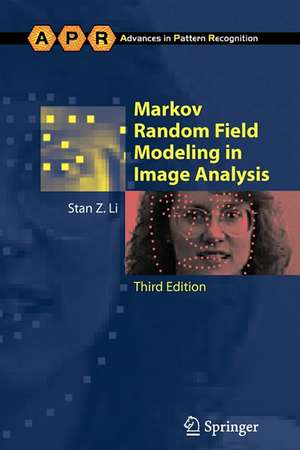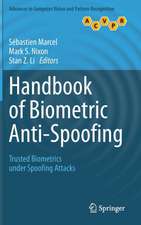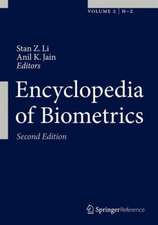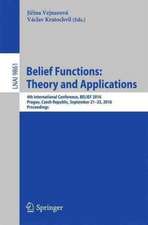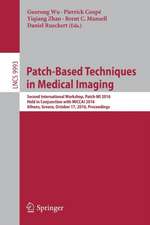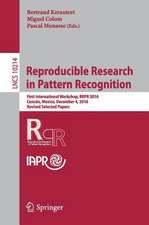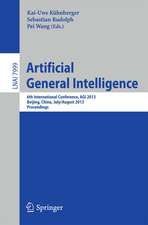Markov Random Field Modeling in Image Analysis: Advances in Computer Vision and Pattern Recognition
Autor Stan Z. Lien Limba Engleză Paperback – 21 oct 2010
| Toate formatele și edițiile | Preț | Express |
|---|---|---|
| Paperback (1) | 983.97 lei 6-8 săpt. | |
| SPRINGER LONDON – 21 oct 2010 | 983.97 lei 6-8 săpt. | |
| Hardback (1) | 988.41 lei 6-8 săpt. | |
| SPRINGER LONDON – 2 apr 2009 | 988.41 lei 6-8 săpt. |
Din seria Advances in Computer Vision and Pattern Recognition
- 20%
 Preț: 991.00 lei
Preț: 991.00 lei - 20%
 Preț: 409.78 lei
Preț: 409.78 lei - 20%
 Preț: 649.88 lei
Preț: 649.88 lei - 20%
 Preț: 769.59 lei
Preț: 769.59 lei - 20%
 Preț: 867.13 lei
Preț: 867.13 lei - 20%
 Preț: 241.87 lei
Preț: 241.87 lei - 20%
 Preț: 654.97 lei
Preț: 654.97 lei - 20%
 Preț: 1076.18 lei
Preț: 1076.18 lei - 20%
 Preț: 326.19 lei
Preț: 326.19 lei - 20%
 Preț: 645.30 lei
Preț: 645.30 lei - 20%
 Preț: 639.92 lei
Preț: 639.92 lei - 20%
 Preț: 647.75 lei
Preț: 647.75 lei - 20%
 Preț: 642.04 lei
Preț: 642.04 lei - 20%
 Preț: 986.28 lei
Preț: 986.28 lei - 20%
 Preț: 1166.25 lei
Preț: 1166.25 lei - 20%
 Preț: 642.04 lei
Preț: 642.04 lei - 20%
 Preț: 667.42 lei
Preț: 667.42 lei - 20%
 Preț: 1157.91 lei
Preț: 1157.91 lei - 20%
 Preț: 913.52 lei
Preț: 913.52 lei - 20%
 Preț: 819.69 lei
Preț: 819.69 lei - 20%
 Preț: 661.68 lei
Preț: 661.68 lei - 18%
 Preț: 946.62 lei
Preț: 946.62 lei - 20%
 Preț: 991.98 lei
Preț: 991.98 lei - 20%
 Preț: 650.20 lei
Preț: 650.20 lei - 20%
 Preț: 595.16 lei
Preț: 595.16 lei - 20%
 Preț: 642.84 lei
Preț: 642.84 lei - 20%
 Preț: 653.49 lei
Preț: 653.49 lei - 20%
 Preț: 1637.42 lei
Preț: 1637.42 lei - 20%
 Preț: 984.14 lei
Preț: 984.14 lei - 20%
 Preț: 986.74 lei
Preț: 986.74 lei - 20%
 Preț: 1054.73 lei
Preț: 1054.73 lei - 20%
 Preț: 977.90 lei
Preț: 977.90 lei - 20%
 Preț: 635.66 lei
Preț: 635.66 lei - 20%
 Preț: 651.21 lei
Preț: 651.21 lei - 18%
 Preț: 943.51 lei
Preț: 943.51 lei - 20%
 Preț: 647.61 lei
Preț: 647.61 lei - 20%
 Preț: 640.06 lei
Preț: 640.06 lei - 20%
 Preț: 989.06 lei
Preț: 989.06 lei
Preț: 983.97 lei
Preț vechi: 1229.96 lei
-20% Nou
Puncte Express: 1476
Preț estimativ în valută:
188.45€ • 194.16$ • 157.86£
188.45€ • 194.16$ • 157.86£
Carte tipărită la comandă
Livrare economică 22 februarie-08 martie
Preluare comenzi: 021 569.72.76
Specificații
ISBN-13: 9781849967679
ISBN-10: 1849967679
Pagini: 362
Ilustrații: XXII, 362 p. 111 illus.
Dimensiuni: 155 x 235 x 20 mm
Greutate: 0.54 kg
Ediția:Softcover reprint of hardcover 3rd ed. 2009
Editura: SPRINGER LONDON
Colecția Springer
Seria Advances in Computer Vision and Pattern Recognition
Locul publicării:London, United Kingdom
ISBN-10: 1849967679
Pagini: 362
Ilustrații: XXII, 362 p. 111 illus.
Dimensiuni: 155 x 235 x 20 mm
Greutate: 0.54 kg
Ediția:Softcover reprint of hardcover 3rd ed. 2009
Editura: SPRINGER LONDON
Colecția Springer
Seria Advances in Computer Vision and Pattern Recognition
Locul publicării:London, United Kingdom
Public țintă
ResearchCuprins
Mathematical MRF Models.- Low-Level MRF Models.- High-Level MRF Models.- Discontinuities in MRF#x0027;s.- MRF Model with Robust Statistics.- MRF Parameter Estimation.- Parameter Estimation in Optimal Object Recognition.- Minimization – Local Methods.- Minimization – Global Methods.
Recenzii
From the reviews of the third edition:
"Prof. Li’s book … provides a comprehensive introduction to the area of MRF in general and to its applications in image processing in specific. … is very well written with a plethora of references for the reader that wants to delve further into specific areas. … In conclusion, this book is very thorough, both in a mathematic and a descriptive manner. Anyone interested in image processing and its applications … can benefit from the variety of provided examples and its wide range of references." (Apostolos Georgakis, IAPR Newsletter, Vol. 31 (4), October, 2009)
"This book elegantly and effectively elaborates on MRF theory and related topics. Each chapter includes the problem definition, related mathematical formulation and method explanations, and very useful examples. … This is an excellent book on MRF theory for image analysis. Researchers and graduate students will find this book very useful for understanding the theory clearly." (Fatih Kurugollu, ACM Computing Reviews, November, 2009)
"Prof. Li’s book … provides a comprehensive introduction to the area of MRF in general and to its applications in image processing in specific. … is very well written with a plethora of references for the reader that wants to delve further into specific areas. … In conclusion, this book is very thorough, both in a mathematic and a descriptive manner. Anyone interested in image processing and its applications … can benefit from the variety of provided examples and its wide range of references." (Apostolos Georgakis, IAPR Newsletter, Vol. 31 (4), October, 2009)
"This book elegantly and effectively elaborates on MRF theory and related topics. Each chapter includes the problem definition, related mathematical formulation and method explanations, and very useful examples. … This is an excellent book on MRF theory for image analysis. Researchers and graduate students will find this book very useful for understanding the theory clearly." (Fatih Kurugollu, ACM Computing Reviews, November, 2009)
Textul de pe ultima copertă
Markov random field (MRF) theory provides a basis for modeling contextual constraints in visual processing and interpretation. It enables systematic development of optimal vision algorithms when used with optimization principles.
This detailed and thoroughly enhanced third edition presents a comprehensive study / reference to theories, methodologies and recent developments in solving computer vision problems based on MRFs, statistics and optimization. It treats various problems in low- and high-level computational vision in a systematic and unified way within the MAP-MRF framework. Among the main issues covered are: how to use MRFs to encode contextual constraints that are indispensable to image understanding; how to derive the objective function for the optimal solution to a problem; and how to design computational algorithms for finding an optimal solution.
Easy-to-follow and coherent, the revised edition is accessible, includes the most recent advances, and has new and expanded sections on such topics as: Conditional Random Fields; Discriminative Random Fields; Total Variation (TV) Models; Spatio-temporal Models; MRF and Bayesian Network (Graphical Models); Belief Propagation; Graph Cuts; and Face Detection and Recognition.
Features:
• Focuses on applying Markov random fields to computer vision problems, such as image restoration and edge detection in the low-level domain, and object matching and recognition in the high-level domain
• Introduces readers to the basic concepts, important models and various special classes of MRFs on the regular image lattice, and MRFs on relational graphs derived from images
• Presents various vision models in a unified framework, including image restoration and reconstruction, edge and region segmentation, texture, stereo and motion, object matching and recognition, and pose estimation
• Uses a variety of examples to illustrate how to convert a specific vision problem involving uncertainties and constraints into essentially an optimization problem under the MRF setting
• Studies discontinuities, an important issue in the application of MRFs to image analysis
• Examines the problems of model parameter estimation and function optimization in the context of texture analysis and object recognition
• Includes an extensive list of references
This broad-ranging and comprehensive volume is an excellent reference for researchers working in computer vision, image processing, statistical pattern recognition and applications of MRFs. It is also suitable as a text for advanced courses relating to these areas.
This detailed and thoroughly enhanced third edition presents a comprehensive study / reference to theories, methodologies and recent developments in solving computer vision problems based on MRFs, statistics and optimization. It treats various problems in low- and high-level computational vision in a systematic and unified way within the MAP-MRF framework. Among the main issues covered are: how to use MRFs to encode contextual constraints that are indispensable to image understanding; how to derive the objective function for the optimal solution to a problem; and how to design computational algorithms for finding an optimal solution.
Easy-to-follow and coherent, the revised edition is accessible, includes the most recent advances, and has new and expanded sections on such topics as: Conditional Random Fields; Discriminative Random Fields; Total Variation (TV) Models; Spatio-temporal Models; MRF and Bayesian Network (Graphical Models); Belief Propagation; Graph Cuts; and Face Detection and Recognition.
Features:
• Focuses on applying Markov random fields to computer vision problems, such as image restoration and edge detection in the low-level domain, and object matching and recognition in the high-level domain
• Introduces readers to the basic concepts, important models and various special classes of MRFs on the regular image lattice, and MRFs on relational graphs derived from images
• Presents various vision models in a unified framework, including image restoration and reconstruction, edge and region segmentation, texture, stereo and motion, object matching and recognition, and pose estimation
• Uses a variety of examples to illustrate how to convert a specific vision problem involving uncertainties and constraints into essentially an optimization problem under the MRF setting
• Studies discontinuities, an important issue in the application of MRFs to image analysis
• Examines the problems of model parameter estimation and function optimization in the context of texture analysis and object recognition
• Includes an extensive list of references
This broad-ranging and comprehensive volume is an excellent reference for researchers working in computer vision, image processing, statistical pattern recognition and applications of MRFs. It is also suitable as a text for advanced courses relating to these areas.
Caracteristici
Comprehensive coverage over a broad range of Markov Random Field Theory Provides the most recent advances in the field Includes supplementary material: sn.pub/extras
